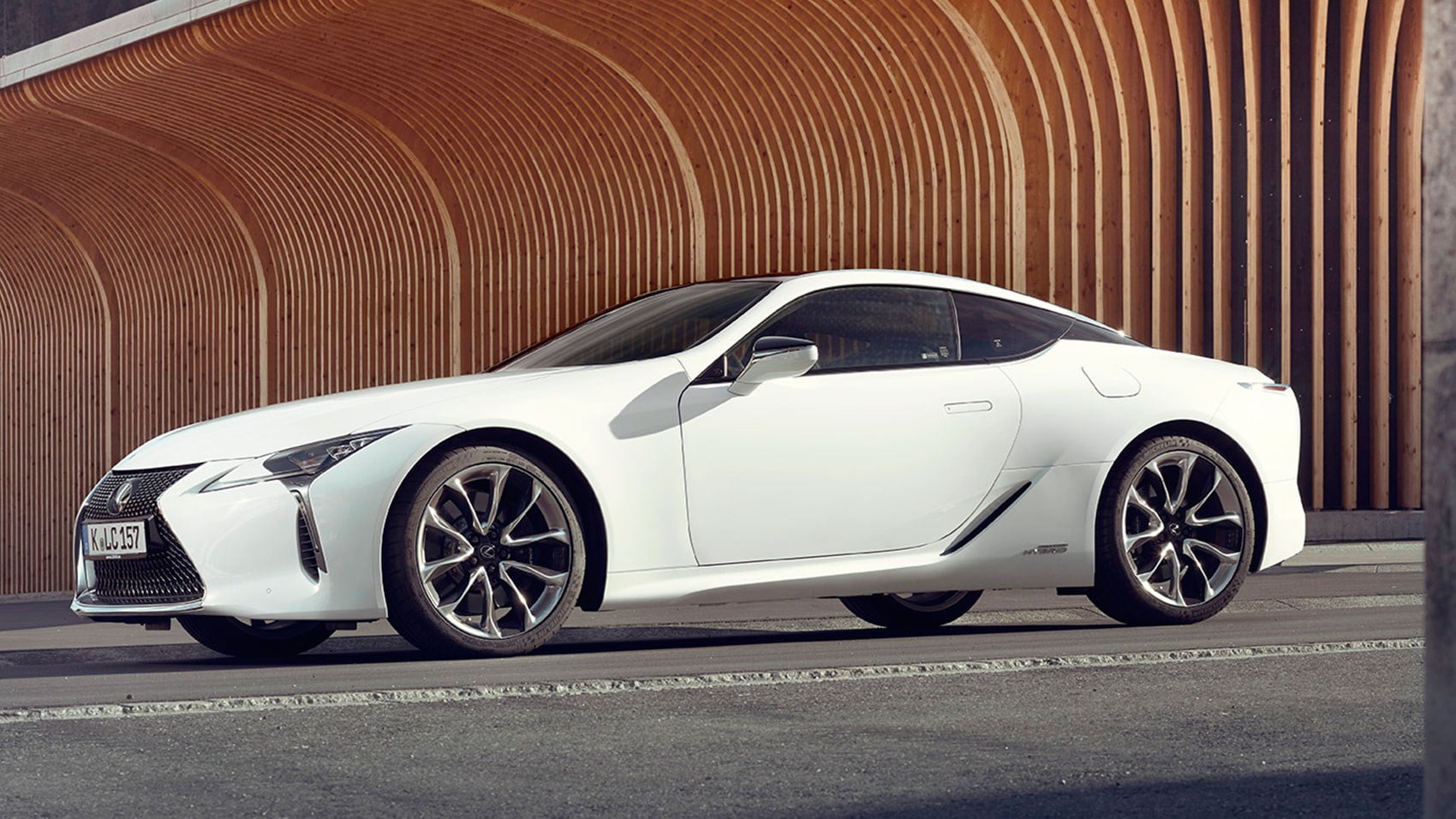 Following our prototype drive of the V8 Lexus LC 500, we’ve had another crack at this Japanese head-turner to see how it stacks up with its other propulsion option – a technologically advanced hybrid called the LC 500h – this time in final production trim.
Following our prototype drive of the V8 Lexus LC 500, we’ve had another crack at this Japanese head-turner to see how it stacks up with its other propulsion option – a technologically advanced hybrid called the LC 500h – this time in final production trim.
Our test route was a schlep from Munich through the Alps, allowing us plenty of time and space to get under the skin of this clever new car. Or so we thought… but more on that later.
Very good, but will people buy it?
Early orders, according to UK director Ewan Shepherd, are looking positive, with almost half of deposits laid down for the LC going towards the 500h, despite its lesser performance against the V8 and identical price tag.
We’re not talking Ford Fiesta volumes here, mind, with the British allocated just 250 of Europe’s 1000 total units. At the time of writing, 162 orders had been placed.

It’s interesting to note that while the majority of V8 LC 500 buyers have gone for the most athletic Sport+ package, most 500h customers have ordered (still very well-equipped) base-spec cars.
There’s a curious dichotomy forming between the two approaches that we’re keen to watch play out to fruition. Which LC will prove most popular once the dust settles?
But first, let us introduce you to a driveline with a difference. A CVT-equipped hybrid with 10 gears – though not all are physical – and not a turbo in sight.
Batten the hatches! Here comes the science
One of the cleverest things about the 500h is its powertrain. Lexus’s Multi Stage Hybrid system is all-new for the LC, and at its heart is a naturally aspirated 3.5-litre V6 with electrical assistance in the form of a 132kW (177bhp) motor – but that’s simply too crude an explanation.
To do the job, an all-new hybrid transaxle has been introduced. This comprises an E-CVT with three distinct ratios (CVTs can have infinite ratios, which originally was one of the advantages of using such a transmission, but here a trio are specified) coupled with a four-speed ‘shift device’ (essentially a conventional automatic gearbox) that adds flexibility.

The result is the simulation of ten gears. The three from the E-CVT are multiplied by three from the shift device for nine, and the final ratio from the latter performs as an overdrive gear, meaning the LC can cruise at high speeds with relatively low engine rpm. And there we have it: 44.1mpg on the combined NEDC alongside a total of 354bhp.
What’s more, with a 6600rpm redline for the motor, 31mph is attainable in first gear. This helps make the five-second 0-62mph time possible.
What’s really impressive here isn’t the hardware, though – it’s the way the LC’s software is configured to manage all this variation across the axle and provide the driver with the optimum gearing for the situation at hand.
What about the battery?
The extra weight and size of the hybrid system has necessitated a move away from the nickel-metal hydride batteries found in earlier Lexus and Toyota hybrids.
This car uses an 84-cell lithium-ion unit instead, weighing four fifths as much as its predecessor while taking up 20% less room.
It’s situated between the rear seats and the boot, unfortunately meaning luggage space is at a premium in the LC. We squeezed a couple of small cabin bags in there but there wasn’t much room left for oxygen.

The LC 500h sounds very clever, but does it work on the road?
That depends on what you benchmark against. If you’re used to traditional approaches like the Maserati Granturismo’s ageing but appealing engine-gearbox-LSD set-up then to start with you’ll be disappointed with the lack of theatre and apparent loss of predictability.
On initial evaluation we found the LC 500h’s driveline erratic and at times disappointingly still afflicted with the dreaded CVT elasticity we’ve grown to dislike so much, made worse by the V6’s less-than-inspiring engine note. The V8 LC 500 is streets ahead here.
However, taken in isolation it’s highly accomplished, if you realise one very important caveat: you need to get to know your LC.
It takes two to tango, and the car needs to familiarise itself with the way you drive, taking into account driver inputs such as the severity of throttle and steering movements to adjust the way the ‘gears’ are served up.

During our test, the system didn’t quite get a fair chance to calibrate itself, especially given that we were sometimes driving in an atypical way to assess chassis response. As a result, gear changes occasionally felt jerky and far too numerous.
Meanwhile the adaptive cruise control seemed to completely befuddle the hybrid system. If it sensed a vehicle in front and slowed by even 10mph the car appeared to struggle to find a ratio to get back to our chosen speed, instead ‘swapping gears’ three or even four times before meaningful acceleration occurred.
Given more time to gel, things started to improve dramatically. And talking about drama, let’s touch on those looks for a second. Borrowing heavily from the LF-LC concept it’s based on, children stop, stare and drop their ice creams when you pass.
But that’s only if they notice you, because the LC 500h can travel in absolute silence for a mile or so before the V6 has to come to the rescue. This is a very cool thing to behold. From the outside it genuinely looks like you’re driving the future.
What’s the Lexus LC 500h’s cabin like?
The interior design is equally likeable, with Lexus’s now-trademark exceptional build quality making for a seriously refined cockpit almost devoid of exterior noise at motorway speeds.
The seats are fantastic too, but we were less enamoured with the fiddly multimedia system. We’re happy the ‘pillow’ control system of yore has been consigned to the history books, but the touchpad still isn’t as slick or intuitive as the rotary one employed by the likes of Audi and BMW.
And on the subject of baffling interior design, if you’re on a fun route you’ve got the option of Sport S and Sport S + modes to liven up the drivetrain, suspension and steering, but they’re controlled via odd rotary stubs mounted on the top corners of the instrument binnacle, roughly at the driver’s eye height.
They don’t obstruct vision but they’re located too far from our favoured driving position, necessitating a bend forwards in the seat to switch modes.
This could be far easier – a simple button by the gear lever would work much better, or even one on the steering wheel itself for an even more ergonomically pleasing solution.
Still, we’re nit-picking somewhat here because overall the new LC is a bit of a design triumph.

Get your specs on
After leaving the Autobahn (top speed: confirmed), we had a chance to test the handling on some sweeping mountain roads.
Keen drivers will want to be wary of this particular LC 500h, because along with the engine sounding and performing far less interestingly than the V8 option, it’s also in the wrong spec: Sport.
Choose a Sport + and you’ll get the variable-rate steering, rear-steer and LSD that transform the LC into a far more accomplished thing in the handling stakes.
And while the LC is an incredibly comfortable car in both Sport and Sport + specifications on the 21-inch wheels, we’d like to try the standard car’s 20s to see just how much better it could get.
The car we’re testing here sits between the two bookends of the LC range, being neither one thing nor the other.
Oh, and make the upgrade to the 13-speaker Mark Levinson sound system. It’s genuinely among the best hi-fi systems we’ve tried – far better-sounding than the drivetrain…
Verdict
By offering the hybrid LC 500h for exactly the same price as the V8, Lexus is polarising its customers. The hybrid will appeal to early adopters and those who like the idea of a relatively environmentally friendly GT car that’ll cover serious mileage in comfort. The V8 is the better drive. You pays your money, you takes your choice.
Ours is a V8 Sport +.
Specs
| Price when new: | £80,595 |
| On sale in the UK: | Now |
| Engine: | 3456cc V6 + 132kW electric motor, total 354bhp @ 6600rpm, 348Nm @ 4900rpm |
| Transmission: | E-CVT/4spd auto with 10 perceived ratios |
| Performance: | 5.0sec 0-62mph, 155mph, 43.5mpg, 148g/km CO2 |
| Weight / material: | 1985kg / steel/aluminium |
| Dimensions (length/width/height in mm): | 4770/1920/1345
|
[“Source-carmagazine”]





